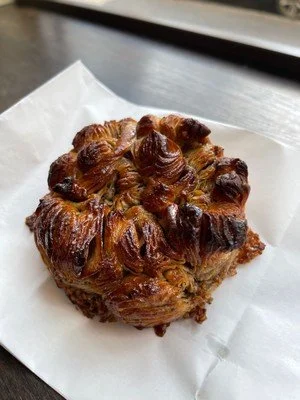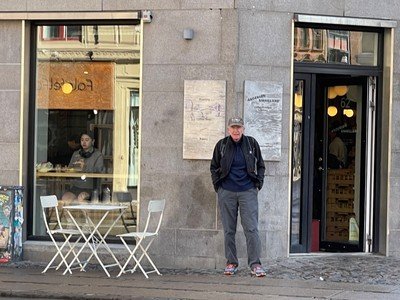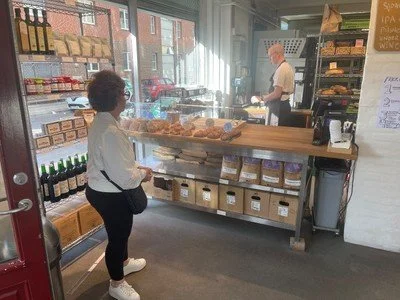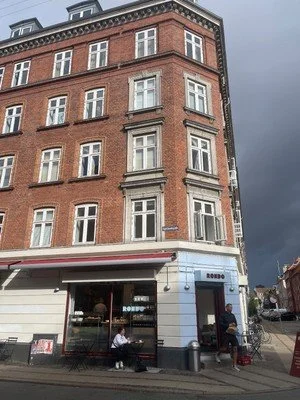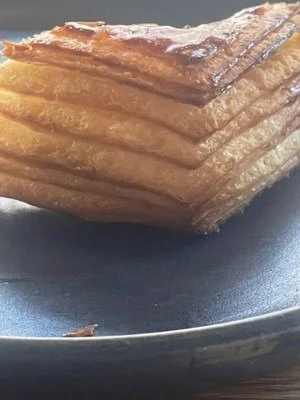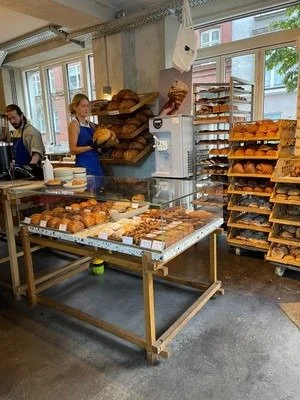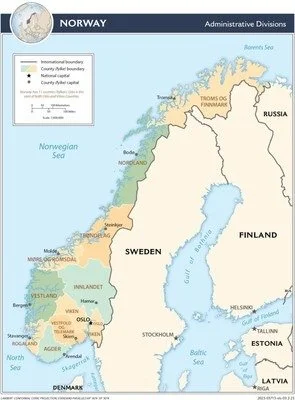Chapter 4: "Farvel," adieu, auf wiedersehen, goodbye...
Sail Away Day
07.22.2023 - 07.22.2023 70 °F
Chapter 04: "Farvel," adieu, auf wiedersehen, goodbye...
Saturday, July 22, 2023
This morning's mission, should we accept it: PASTRY. We seek out Copenhagen's "best bakery."
My favorites to try are Danish kanelsnegl, a "morning bun" which is a flaky pastry with a gooey cinnamon core snug beneath a sugar glaze, and, the spandauer, another flaky pastry but this one filled with custard crème and adorned with almond slivers. This most cherished of Denmark's wienerbrød pastry is so named, I am told, because its shape resembles the prison in Berlin’s Spandau district. The filling, named forJacob Marstrand, former magistrate and baker, is a marzipan custard technically dubbed the Mayor's Mass, or borgmestermasse. Knowledge of these obscurities makes them taste even better. Neither appeals to you? Then try a rabarberhorn, frøsnapper, hindbærsnitter, direktørsnegl, kanelstang or kanelsneg.We stopped at three contenders, B4 was full after the second.
First was Rondo for a kanelsnegl morning bun. Hidden away in a residential area, the place is tiny with only a bit of outside seating. As we finished up, the rain began and we feared the worst. But, as we made our way to Andersen & Maillard for a delicious spandauer, we were able to duck into an alley as the downpour came and went as might an American tourist. Finally, we were off to Benji for a crispy Coco. These three bageri tied for best. You might be wondering how we found these three bakeries to contend for 'the best'? Most tourists would ask the hotel concierge for a recommendation. Paul, as most of you know, is not the typical tourist; and he possess the male gene - on steroids - that doesn't allow men to ask directions on anything. Last nights late night activity, while I read, Paul watched multiple uTubes in a study of the best bakeries in Copenhagen. He picked the three top contenders and mapped them out. We have done 'bake off's' so to speak with our friends in Florida over tuna fish brands and chocolate syrup - anyone remember Bosco? Also George's ATM password if you are a Seinfeld offionado as we are - this was our first pastry tour. The others were much less caloric!
Our Hop On Hop Off Bus pass is still good if we want to use it and we have a late checkout for the Marriott so the morning is stress free other than constant outdoor advertising urging us to go to the movies. One other spectator option is beneath our sixth floor hotel room window where a water taxi passes a series of kayak polo players on the Nyhavn River which was dug out by Swedish prisoners of war from the Dano-Swedish War 1658–1660. The air temperature there is 60 degrees with the water slightly warmer at 64 degrees. A wet suit would be a good idea but there are several swimmers who shun that warming attire.
The Marriott does not offer a self-service laundry facility but that doesn't stop our neighbors around the corner and down the hallway from creatively window drying their freshly laundered underwear. Their practice is not unique, there are several windows thusly utilized with this one being the most photogenic. If one will only take the time to look, there is much to be seen from Marriott corner king, room number 626.
We sailed tonight at 6:00pm, saying "Goodbye" (Farvel) to Denmark, by way of the newish Silversea ship Silver Dawn whose first voyage was just 15 months ago. She holds 596 guests served by a crew of 411. Most passengers are older and wealthier travelers who like white gloved butlers hovering about. Sounds like us. We are allowed to board at any time after 2:00pm. We're amazed at how many children are aboard. Who brings a ten-year-old on a swanky ship to see fjords? There are so many cruise lines that offer kids and young-adult activity programs available that I would think those would be superior options from a kid-perspective. This ought to be interesting.
One might quickly inquire why, if we are cruising in Norway, aren’t we supposed to be on Norwegian Cruise Line ship? But Norwegian Cruise Line, now incorporated in Bermuda with Miami headquarters, hasn’t been under Norwegian ownership since 1966. After beginning as a car ferry operator, Norwegian founders Knut Kloster and Israeli Ted Arison sold the line to Star Cruises of Hong Kong—who introduced the casual cruising style by which it is now known. Half of the company was then sold to Apollo Management and subsequently sold again to TPG Capital before the entire operation went public in 2013. Today, despite its name, it has no relationship to Norway. We’re on Silversea which is a subsidiary of Royal Caribbean Cruise Line--which operates Royal Caribbean along with Celebrity ships in a good, better, best product lineup.
Since Copenhagen was widely covered in yesterday’s entry, it seems only fitting that we use this space to introduce Norway. When you think of Norway, what comes to mind? One friend said, “Sweden.” B4 said, “cold.” Now, almost exactly a dozen years since I was last here, I return to this part of the world with B4 at my side. (In 2019, I returned alone to Oslo stopping on my way to Svalbard on a quest to commune with polar bears. That blog can be read at https://RussellArctic.travellerspoint.com ) On this Norway trip, however, Oslo isn’t on the menu
Instead, we are here to feast upon fjords (prounounced fyord), long and narrow and very deep bodies of water that jut far inland. 2.5 million years ago, glaciers gouged out the Norwegian landscape. Norway hosts over 1,000 fjords, more than in Chile, New Zealand, Canada, Greenland and Alaska, the only other places on earth where they are found. Fjords are almost always walled by steep rocks on either side from the opening to the sea, called the “mouth.” Technically, if a body is wider than it is long, it isn’t a fjord.
“Fjord” is one of the few Norwegian words that have become international. Fjord comes from the Norse fjǫrðr meaning "where one fares through.” Fed by snow melt, fjord waters run deep, are very cold and normally are quite calm, free from wave activity found in open seas.
Aboard ship, we have booked a “Silver Suite,” one step nicer than regular balcony accommodations but less extravagant than the opulent Owner’s, Grand or Royal Suites. We have seven days and nights before ending our voyage at Bergen, Norway.
I don’t really know what to expect other than a golden opportunity for puns. For example, in Norway, a speed bump—that hump in the road that makes you slow your car down or risk bumping your head on the roof—is called a Farts-dempere. “Farts” translates to “speed.” Write your own fart joke here.
Norway was initially ruled by Denmark. But in 1814, by the Treaty of Kiel, Sweden took control of the country. Denmark had sided with the defeated Napoleon Bonaparte so, in effect, control of Norway hinged with the outcome of the Napoleonic wars. I visited Napoleon's grave years ago on the island of Saint Helena; he ended up a defeated exile there.
Norway accepted the Swedish monarch but retained its existing constitution and legislature and demanded its own national flag and consular service in order to promote overseas commerce. Sweden resisted. In 1905, Norway declared separation from Sweden and, in a way, reverted choosing Prince Charles of Denmark as king. He promptly took the name of Haakon VII and ruled for over fifty years from the capital of Oslo. The U.S. government recognized this legal separation and diplomatic relations began.
Nazi Germany invaded in 1940 and the Oslo government was forced to flee to England. The U.S. Minister left followed soon after by the U.S. Chargé d’Affaires. After the war ended in 1945 a U.S. embassy was opened in Oslo and remains there.
Approximately 5 million people call Norway home, exporting around $7 billion to the U.S. while importing about $9 billion making the country our 44th largest trading partner. We send them vehicles, aircraft, machinery and mineral fuels. They send us tree nuts, processed fruit, wine & beer, prepared foods and vegetables.
Norway is led by King Harald V and Prime Minister Erna Solberg.
The Norwegian flag is red with a blue cross outlined in white. The vertical part of the cross is shifted to the “hoist” side in the style of the Danish flag. The colors signify past political unions with Denmark (red and white) and Sweden (blue).
The Norwegian kroner currently trades at about ten cents U.S. The major languages spoken are Bokmal Norwegian and Nynorsk Norwegian but some minority groups speak Finnish or Sami. Evangelical Lutherans are almost 70 percent of the population. The remainder who declare beliefs are split evenly between Muslim, Roman Catholic and other Christian. The Jewish population stands at approximately 1400 to 1700 people, the smallest religious group in Norway. Antisemitism is unfortunately alive and well in Norway which has a long and ugly history on that front. Jews were expelled in 1687 and, in 1814, a ban on Jews was constitutionally ordained--only to be reversed in 1851. During World War II, as a Jew, of the Scandinavian countries, you would not have opted for Norway where, under Nazi occupation, 772 Jews were deported, 740 of whom were killed in the camps. During that period Denmark or Sweden were much better situations.
The time here is 7 hours ahead of Central time.
Soccer dominates the sporting scene - Ted Lasso anyone? - but winter sports are also popular: biathlon, cross-country skiing, ski jumping, speed skating and hockey. Norwegians frown on boastfulness, jealousy and flamboyance following a tradition known as janteloven, based on a popular author’s books; "Jante Law" places society ahead of the individual. This restrained behavior concept is, of late, getting some pushback with some suggesting it promotes a lack of self-esteem and aversion to entrepreneurial spirit.
Littering is unheard of, recycling is universally popular and volunteering to help revered. Taxes are high but not unpopular.
If you come here, popular items to purchase as souvenirs are wool sweaters and socks and even moose or troll-themed knickknacks. Try the “farikal,” a mutton and cabbage concoction simmered for hours in a large pot. Be prepared for temperate weather along the coast but colder conditions inland. Summers are wet and cold. Our journey will end in Bergen where summertime highs in July and August only reach about 67 degrees. Low temperatures are moderated by proximity to the ocean and seldom fall below freezing. As one goes inland or to higher elevations, temperatures fall.
Trondheim experiences wet summers. Tromsø is inside a small fjord and is also cool. Within fjords, temperatures fall—the deepest ones can freeze in the winter months. But that is months from now. With southern Europe--and a good portion of the United States--sweltering under triple-digit heat, this cool weather is a blessing. It will possibly make our balcony less appealing and the ship's pool a waste of space. Other than for Alaska, Atlantic crossings and fjord hopping, these ships are mostly built for warmer climes.
We shall see.
